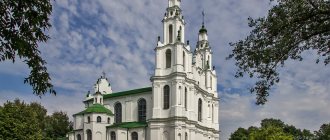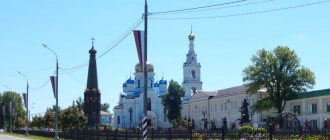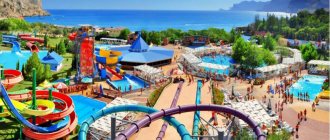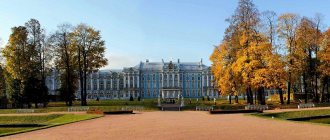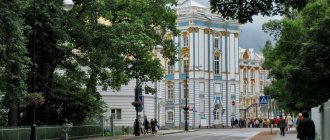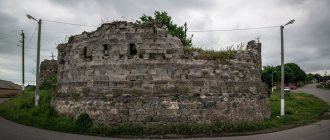Polotsk awaits tourists from Belarus who decide to go to the Vitebsk region. Its sights will tell and clearly show why the oldest city of the Republic is interesting, first mentioned in 862 in the “Tale of Bygone Years” and stretching along both banks of the Western Dvina, near the place where the Palata River flows into it. During its thousand-year life, Polotsk has seen a lot: paganism, chivalry, peaceful times and years of bloody battles. What is the first thing to see in it?
Polotsk: TOP-3 places worth seeing in 1 day
All newly arrived tourists are confused by the countless attractions of Polotsk. Where to start? This section contains the most interesting places in the city that you can easily see in one day.
Cathedral of Sophia the Wisdom of God
- Address: Lenin Avenue.
St. Sophia Cathedral was built in 1060 and became the first stone building in the country. However, the original Byzantine building has not survived to this day. In the second half of the 18th century, the exterior and interior layout were significantly changed by the architect Johann Glaubitz, who endowed the building with Vilna Baroque features.
This is exactly how he appears to us today: majestic and graceful. On both sides of the main building rise multi-tiered bell towers topped with emerald-colored domes.
In 1705, Peter I visited the cathedral. Or rather, he did not visit, but drunkenly invaded the shrine in the company of soldiers. When the emperor demanded that he be given the keys to the royal gates, behind which the relics of Josaphat Kuntsevich were kept, church officials refused him. Then the angry king personally killed the abbot and several monks, and ordered their bodies to be thrown into the Dvina.
This incident provoked the closure of the cathedral. A gunpowder warehouse was placed in its basements, which exploded in the spring of 1710. The half-destroyed church lay in ruins for 20 years and was restored in 1738.
The cathedral was active until the 1920s, when persecution of believers began and most religious buildings were closed. For a long time, the Local History Museum operated in the premises of the church. Liturgical activities resumed in 1983 after a large-scale restoration. Nowadays, divine services are regularly held here, and a museum dedicated to the history of the cathedral has been opened.
Museum of Medieval Knighthood
- Address: st. Engelsa, 3.
The Museum of Medieval Chivalry is not very large, but it can surprise visitors with an impressive exhibition. Three exhibition halls present:
- Knight armour,
- weapons (bows, spears, swords, shields),
- items of medieval life.
The premises are decorated in the style of stone castles with stained glass windows and torch lamps. For those who don’t mind tickling their nerves, there is a “Torture Chamber” - a basement room where the instruments of execution are stored - the rack, the “Spanish boot”, the “pear of suffering”, the “crocodile pipe” and others. On the tour you will be told how these instruments were used in the cruel medieval era.
Memorial sign “Polotsk - the geographical center of Europe”
- Address: Francysk Skaryna Avenue.
In 2008, Belarusian geodesists calculated the geographical center of Europe. The identified coordinates - 55o30′ north latitude and 28o48′ east longitude - showed that it is located on the territory of Polotsk.
In honor of this event, a memorial sign depicting a map of Europe appeared on Francysk Skaryna Avenue. A hemisphere rises above it, in the center of which there is a golden boat - the symbol of Polotsk. At the foot of the composition you can see four arrows - a compass indicating the cardinal directions.
description
Polotsk is an ancient Belarusian city on the Western Dvina and Polota rivers.
It has the status of the administrative center of the Polotsk region. Polotsk is connected by highways to Braslav, Lepel, Vitebsk, Glubokoe, and Rossony. From Polotsk roads lead to the borders with Latvia, Lithuania and Russia. 3d panorama. Polotsk, Francisk Skaryna Square
Polotsk is a railway station in the direction of Vitebsk, Nevel, Molodechno and Daugavpils. Passenger trains run through Polotsk to Gomel, Moscow, Minsk, Molodechno, Postavy, St. Petersburg, Kaliningrad and Riga.
About 85 thousand people live in Polotsk. The city is called the center of the Polotsk agglomeration, the largest settlement of which is Novopolotsk.
Geographically, the region covers an area of about 800 square meters. km., where more than 200 thousand people live. The majority of residents of the agglomeration are employed in the oil refining, chemical and food industries. Since 2008, Polotsk has been recognized as the geographical center of Europe.
The most interesting museums in Polotsk
Museums are the pride and heritage of Polotsk. They preserve evidence of past centuries and reflect the cultural characteristics and values of the city.
Museum of Local Lore
- Address: Lenin street, 11.
The oldest museum in Polotsk was founded in 1926. Its initial exhibition was located in the closed and converted St. Sophia Cathedral, and later moved to the building of the former Lutheran Church - a red-brick building in the neo-Gothic style, erected in the second half of the 18th century. It is easily recognized by its pointed towers and high spire.
The Great Patriotic War caused serious damage to the museum collection: ancient manuscripts, a valuable library and a collection of weapons were destroyed. The modern exhibition is based on surviving exhibits. It has more than two thousand storage units. Today there are several permanent exhibitions:
- “Archaeology” is an archaeological exhibition displaying artifacts of the Neolithic era - tools and protection, ceramics, amulets made from animal bones, stone figurines.
- "History of the Patriotic War of 1812." Here are collected relics of the war mentioned in the title - original uniforms, samples of weapons, banners.
- “Corner of a Belarusian hut of the 19th-20th centuries.” The exhibition is dedicated to ethnography and illustrates the life of Belarusian peasants.
The museum's archives also contain photographs, historical papers, ancient coins and rare books.
Natural and Ecological Museum
- Address: st. Francysk Skaryna, 21.
The museum was founded in September 2005. It was located in the premises of a disused water tower. In Soviet times, the 32-meter structure provided the city with water, but now serves as a storage facility for thousands of natural exhibits.
The museum consists of four levels, the communication of which is carried out using a glass staircase symbolizing the Tree of Life:
- The first level is called “Belarus is our home.” It is dedicated to the biological diversity and unique nature of the country.
- At the second level - “Given to Civilization” - tourists will get acquainted with the problems of environmental pollution in modern cities, including Polotsk.
- The third level is called “Protected territories”. Here the story will be about protected areas, endangered species and the preservation of natural monuments.
- The fourth level is a conference room where lectures and film screenings are held. There is also an observation deck here, which offers an impressive view of the city panorama.
Museum of Belarusian Printing
- Address: st. Lenina, 22.
The institution is located in the building of a former monastery school, which belonged to the Epiphany Orthodox monastery. The white stone structure of the 18th century is protected as a historical and architectural monument. The museum began functioning in the fall of 1990. Its opening was timed to coincide with the celebration of the 500th anniversary of the birth of the Belarusian pioneer printer of the 16th century, Francis Skaryna.
The attraction's exhibitions demonstrate the evolution of books, from ancient scrolls to modern editions. During the tour, visitors get acquainted with the history of writing, the improvement of stationery, and the technology of printing and binding books.
The exhibition occupies 15 halls and includes more than 2,500 exhibits, as well as an extensive library of Belarusian literature. At the exit from the museum, there is a souvenir shop where you can independently buy art and scientific books, rare newspapers and magazines, gift cards and calendars.
Children's Museum
- Address: Nizhne-Pokrovskaya, 46.
The children's museum is located in a small house located in the middle of a flower garden. At the entrance, guests are greeted by bronze figures: “Girl with a Clock” and “Schoolboy”. The exhibition is divided into several halls:
- The “Hall of Inventions” introduces little excursionists to such devices as a camera, scales, a samovar, and a bell. Children are allowed to pick up objects, press buttons and look at them in any way they want. The purpose of the interactive excursion is to help children understand the essence of the inventor’s profession. Portraits of famous scientists are hung on the walls of the hall so that children can see the faces of engineering geniuses.
- "Children's room". There is a comfortable and even playful atmosphere here. Children's books and toys are scattered throughout. In this room, educational quizzes, educational games and exciting quests are organized.
- "Collections of small residents of Polotsk." The exhibition was created through the efforts of the city's children's population. The display cases display badges, stamps and toys that young residents of Polotsk donated to the museum. The collection is constantly updated, and anyone can contribute.
Travel tips
When visiting the cities of Belarus, including Polotsk, follow certain rules that will help you avoid unpleasant moments during your vacation:
- name the country correctly. Many visitors pronounce "Belorussia", and some locals do not like it. The official name of the country is “Belarus”;
- do not smoke in public places, and do not drink alcoholic beverages, including beer. The list of prohibited places includes balconies of houses and hotels;
- do not leave minor children unattended on the city streets after 23.00;
- Park your car only in permitted places, otherwise your car may end up in a parking lot in a short time;
- do not photograph train stations, government buildings, or military installations.
Religious objects and Polotsk churches
Religious institutions and shrines of Polotsk come from ancient eras, belong to different architectural styles, but have a common spiritual and educational goal.
Spaso-Euphrosinievsky Monastery
- Address: st. Euphrosyne of Polotsk, 89.
This convent is the oldest and largest Orthodox center in all of Belarus. The monastery was founded in 1125 on the initiative of Princess Euphrosyne of Polotsk.
The single-domed Church of the Transfiguration of the Savior is recognized as its most significant building. It is an impeccably preserved example of ancient Polotsk architecture. On the territory of the monastery there are also:
- Holy Cross Cathedral,
- belfry,
- refectory church,
- cells and chapels.
All buildings are made of white stone in the neo-Byzantine style and were built between the 12th and 19th centuries.
For a long time, the main relic of the monastery was considered the Cross of Euphrosyne of Polotsk - a precious altar crucifix with particles of the Sepulcher and the Cross of the Lord. After the monastery was closed in 1921, the relic was transported to Minsk and lost in 1941 during the German occupation.
The cross has not been found to this day, but in the late 1990s. Brest jeweler Nikolai Kuzmich made a perfect copy of the jewelry, which is now exhibited in the Transfiguration Church in place of the missing shrine.
Church of the Intercession of the Blessed Virgin Mary
- Address: ave. Francysk Skaryna, 42.
The original wooden church was erected in 1781 as a cemetery church, but later acquired the status of a parish cathedral. In 1838, the Polotsk diocese decided to demolish the dilapidated church and build a new one in its place - a white stone one.
Architect M.I. Domakurov built a beautiful building in the neo-Byzantine style, decorating it with arched windows and figured masonry. The main building and the adjacent tented bell tower were crowned with golden domes.
The church served parishioners until 1930, when the Soviet government banned religious activities. The building remained abandoned for 14 years, and after the liberation of Polotsk from the occupiers in 1944, a chocolate factory opened in it.
In the 1960s There was a strong fire at the production facility that destroyed the building. It was restored in 1991, but no longer as a factory - the building was returned to its temple status. The Church of the Intercession was reconstructed and re-consecrated in 2004.
Borisov stone
- Coordinates on the map: 55.485717, 28.758072.
Borisov stones are massive boulders with carved crosses and typical inscriptions: “God, help your servant Boris.” According to the theory of historians, these blocks and boulders were created at the behest of Boris Davydovich, the ruler of the Polotsk lands in the 12th century.
The described specimen was discovered in the waters of the Western Dvina at the end of the 19th century, but it was only brought to land a century later. The 3-meter stone has a reddish color, uneven shape and rough surface. The carved cross and the inscription have been erased by time and are practically invisible. Borisov Stone is considered a shrine and spiritual heritage of the city.
How long does it take to explore the city?
You need to come to Polotsk for two days or more: it is impossible to see all the sights in one day, despite the small size of the city.
If you have two days at your disposal, then one day can be spent visiting religious places: St. Sophia Cathedral, St. Euphrosyne Monastery, and the second day can be devoted to visiting the monuments and museums of the city.
If you have free time after exploring the city, be sure to take a walk along the picturesque banks of the Western Dvina, which are beautiful at any time of the year.
Walking along the banks of the Western Dvina near Polotsk, you can admire the beautiful scenery
If you stay in Polotsk for a longer period of time, you can visit one of the local farmsteads:
- “White Lake” is located 4 km from Polotsk. Address: Polotsk district, Gendiki village, 27. At guests' disposal is a cozy wooden house with a fireplace, bathroom, washing machine and other amenities. Here you can: rent a boat;
- fish on White Lake;
- visit a Russian bathhouse;
- organization of hunting and fishing;
At the Okhotny Dvor agro estate, guests are accommodated in two-story wooden houses with all amenities
Unique architecture of Polotsk
The development of the city of Polotsk is impressive in its diversity. In addition to modern buildings, there are unique structures protected by the state as monuments of folk architecture.
College of the Jesuits
- Address: Streletskaya, 4.
The educational institution was founded in the distant 16th century by Prince of Lithuania Stefan Batory. The wooden building burned to the ground in 1740, and St. Stephen's Cathedral was erected in its place.
The Jesuit school was revived in 1750. Then a three-story stone building was built for his needs, which still stands today. Such outstanding personalities as
- Jan Cywinski (Catholic bishop),
- Valentiy-Wilhelm Vankovich (artist),
- Martin Poczobut-Odlanicki (Belarusian astronomer and mathematician).
On the territory of the college you can find many interesting attractions: bronze sculptures and monuments are installed along the alleys, there is an ancient clock in the courtyard, and there is an art gallery in one of the buildings.
House of Peter I
- Address: Nizhne-Pokrovskaya st., 33.
The small house was built in 1692 in the Baroque style. This is a one-story building in the shape of an irregular rectangle. Its façade is decorated with frequent windows with carved frames and figured cornices. The end is decorated with stucco, rosettes and an attic.
The house was built for Peter I, who lived in it in the summer of 1705 during the Northern War. In subsequent centuries, the building was rebuilt several times, but in the 1990s it was returned to its original appearance. Nowadays there is a museum here.
Fire Tower
- Address: Zamkovy Proezd.
The 33-meter fire tower appeared in 1927 and became the final element of the fire department building. At all times, Polotsk had predominantly squat buildings - even to this day, the only rival to the six-story tower in terms of height is St. Sophia Cathedral.
Despite the fact that the tower stands out against the background of low buildings, it is in perfect harmony with the overall architecture. Her formal style is enlivened by a pretty pink color scheme. The old fire station is still in operation today, but the tower is no longer used to detect fires. Now it plays an aesthetic role and often appears on souvenir postcards as one of the most recognizable buildings in the city.
Story
Polotsk is one of the oldest cities in Belarus, named after the Polota River. It was first mentioned in the Tale of Bygone Years in 862. Located on a major trade route, Polotsk developed rapidly. In the 10th century, the Principality of Polotsk was formed on these lands, which for three centuries was one of the largest and most powerful state entities. Initially, the Principality of Polotsk occupied territories in the Western Dvina basin, in the upper reaches of the Berezina and Neman. At different times, the legendary princes Rogvolod, Bryachislav, Vseslav the Magician, Andrey of Polotsk stood at the head of the Principality of Polotsk.
In the XIV-XVI centuries, Polotsk was the largest city in the Grand Duchy of Lithuania, which had special “Polotsk privileges”. In 1498, Polotsk received Magdeburg Law. Since 1504, the city was the center of the voivodeship of the Grand Duchy of Lithuania, and later of the Polish-Lithuanian Commonwealth. As a result of the first division of the federation, the right bank part of Polotsk became part of the Russian Empire. The left bank was annexed twenty years later, after the second division of the lands. Polotsk became the administrative center of the Polotsk province, and then of the governorate. At the turn of the 18th-19th centuries, Polotsk developed as a county town in the Belarusian and then Vitebsk provinces.
Since 1924, Polotsk became part of the BSSR. For three years during the Second World War, the city was under occupation. Polotsk, liberated in 1944, suffered colossal casualties and was almost completely destroyed. The city, which became the center of the Polotsk region, had to be thoroughly restored. Now Polotsk is a district and also the administrative center of the Polotsk agglomeration, a large industrial hub. The city has successful food and textile enterprises and the only fiberglass production plant in Belarus. Thanks to its historical, cultural and architectural heritage, Polotsk is also developing as a tourist center of international scale.
War memorials and monuments
Polotsk has survived many wars and does not forget its heroes, despite the unstoppable passage of time.
Mound of Immortality
- Address: st. Mound of Immortality, 1.
The mound was erected in 1966 in memory of the Polotsk residents who died in the battles of the Second World War. The peculiarity of the 10-meter embankment is that it contains soil from the sites of major battles and mass graves, as well as the ashes of villages burned by the Germans.
The architect of the attraction was N.P. Glazunov. He gave the ground a pyramidal shape and installed a bowl with the Eternal Flame on top. At the foot of the mound there is a memorial slab, at which there are always fresh wreaths.
Monument to the liberators of Polotsk
- Address: pl. Freedom.
The memorial is located on Freedom Square. It is a wall made of hewn stones with a bronze high relief of three Soviet soldiers holding a banner. The monument is dedicated to the Red Army soldiers of the First Baltic Front - the heroes who liberated Polotsk from the German occupiers on July 4, 1944. In front of the memorial there is a small platform on which the Eternal Flame is installed.
Red Bridge
- Address: Euphrosyne Polotskaya Street.
The bridge over the Palata River was named "Red" in honor of the battle that took place there in the fall of 1812. The battle between the Russian and French troops was so fierce that the wooden deck of the bridge was stained with blood.
In 1975, the battle site underwent restoration. The dilapidated wooden walkway was replaced with reinforced concrete, preserving the elements of the previous design. At the entrance you can see a memorial sign with a memorial inscription telling about the origins of the name of the building.
Monument to the heroes of the Patriotic War of 1812
- Address: pl. Freedom.
The monument rises in the center of Freedom Square. This is an impressive stele in the shape of a hexagonal pyramid, decorated with figured columns on the sides and topped with a dome with a golden cross on top.
It is located on the site of the original monument, which was erected in the mid-19th century. The opening ceremony took place in 1850, and was attended by Tsarevich Alexander Nikolaevich, the future Emperor Alexander II. The monument was demolished in 1930 and replaced with a statue of Lenin.
The monument to the heroes of the Patriotic War of 1812 was revived only in 2010. The updated stele completely repeats the architecture of its predecessor. On both sides of it there are models of guns used in the battles of that war.
Spaso-Efrosyne Monastery
This is the oldest and largest female Orthodox monastery in Belarus. It was founded in the 12th century by Princess Euphrosyne, when she and her sisters took monastic vows. Thanks to the nuns, a few years later a temple was built in the monastery.
After the capture of Polotsk by the troops of the Polish-Lithuanian Commonwealth, the monastery was given to the Jesuits, who owned it until the beginning of the 19th century. Later, the Jesuits were expelled from the city, and the monastery was transferred to the sovereign's treasury.
During the Soviet era, the monastery was closed and practically destroyed along with the churches. Today it has been restored, the monastery is active, nuns live here, tourists come here for educational excursions.
The main monuments and sculptures in Polotsk
The streets, squares and gardens of Polotsk are decorated with the works of talented sculptors. These works are not as great as architectural monuments, but nevertheless they contribute to the appearance of the city, giving it individuality.
Monument to Prince Vseslav the Magician
- Address: corner of Oktyabrskaya and Evfrosinya Polotskaya streets.
Vseslav Bryachislavovich - Prince of Polotsk, who ruled in the 11th century. He was nicknamed “The Sorcerer” because he always seemed to the people to be a mysterious and even mystical person. The monument to the legendary ruler was erected in the fall of 2007.
Minsk resident Alexander Prokhorov acted as the main sculptor. He depicted the prince galloping on a mighty horse. Vseslav is dressed in princely attire, and behind his shoulders is a cloak of wolf skin. The sculpture became the first equestrian composition on the territory of Belarus.
Monument to Euphrosyne of Polotsk
- Address: corner of Kommunisticheskaya and Euphrosyne Polotskaya streets.
Euphrosyne of Polotsk was the granddaughter of Vseslav Bryachislovovich and went down in the history of Belarus as a benefactor who built several churches at her own expense. After her death, she was canonized.
A monument to the devout woman appeared in Polotsk in the fall of 2000. The famous sculptor Igor Golubev depicted Euphrosyne in a church cassock flowing to the steps and holding a cross in her hand. Subsequently, copies of this sculpture were installed in many cities of Belarus.
Monument to Simeon of Polotsk
- Address: Engels street, 8.
In 1629, the future writer, theologian and scientist Samuil Gavrilovich Petrovsky-Sitnyanovich was born in Polotsk. He received the nickname “Polotsk” in gratitude for his contribution to the development and education of the city.
Upon completion of his education, Simeon took monastic vows and devoted his life to worship. His sermons were attended by the family of Prince Alexei Mikhailovich Romanov, and Princess Sophia called Polotsk her spiritual mentor.
The monument to such an outstanding personality was erected in 2003. The opening ceremony was timed to coincide with the Day of Belarusian Literature. Cast in bronze, the elder appears before the viewer in monastic vestments, leaning on a music stand, where sheets of paper with a prepared sermon lie.
Monument to the Krivichs
- Address: st. Streletskaya, 4.
Krivichi are East Slavic tribes considered the founders of Polotsk. The composition of Alexander Shaternik’s work is dedicated to them. The Art Nouveau sculpture depicts a boat ruled by Princess Rogneda and her son Izyaslav. They are accompanied by warriors, ready to rush into battle at any second, protecting their masters.
Rogneda, the wife of Prince Vladimir, tried to stab her husband while he was sleeping. The woman was driven by a thirst for revenge because he forcibly took her as his wife, having previously killed her entire family. But the prince woke up and managed to dodge the fatal blow. After this, Rogneda and Izyaslav, who protected their mother from their father’s rage, were exiled to Polotsk, where the boy became the founder of the Polotsk branch of princes.
Monument to the letter "Ў"
- Address: Francysk Skaryna Avenue.
The letter “Ў” is a symbol of the Belarusian alphabet and a truly unique letter, the like of which is not found in any language in the world. The sound it denotes makes Belarusian speech soft and melodic. The bronze monument to the letter “Ў” was unveiled in 2003 in honor of the Day of Belarusian Literature. It is made in the form of a book, on the cover of which are written words starting with this letter.
Events
On June 5, Polotsk celebrates the Day of Remembrance of St. Euphrosyne, Abbess of Polotsk. This day begins with a festive liturgy in the St. Sophia Cathedral and continues with large and small religious processions from churches, as well as a concert. Solemn services are held in Polotsk churches.
International festival of organ music “Calls of Sofia” is an autumn event. Every year, since 1996, at the end of October and beginning of November, musicians from various European countries perform in the concert hall of the St. Sophia Cathedral. At the end of summer, the festival of medieval culture “Rubon” takes place in Polotsk. It attracts historical reconstruction clubs from all over Belarus and neighboring countries. The holiday program includes knightly battles, ancient crafts, ancient cuisine, music and dancing. Blueberry ecofest is another Polotsk summer festival. It starts at six in the morning, when participants with baskets and buckets go into the forest to buy blueberries. The competition lasts several hours, after which the picker with the most berries wins. In the city, the berry festival continues on Francysk Skaryna Avenue and Square - with songs, dances, and games in honor of blueberries. The main treat of the ecofest is a multi-meter blueberry pie.
Attractions in the vicinity of Polotsk
After a long walk around the city, it’s nice to relax in nature. From the final paragraph of this article you will learn about the best green corners of Polotsk and its surroundings.
City beach on the Dvina
- GPS coordinates: 55.482824, 28.775096.
In the summer, the swimming season opens in Polotsk, and as a result, all those who like to splash in the pleasant, cool water go to the beach. The bank of the Dvina is well equipped - there are parking lots, sun loungers, changing cabins and dry closets.
The area is kept clean: walking dogs, littering and lighting fires is prohibited near the river. The bank is grassy, the river bottom is sandy, sometimes there are small stones. Swimming here is completely safe, but just in case there is a lifeguard station near the river.
Lake Lyukhovo
- Coordinates: 55.517735, 28.617091.
The lake is located 10 km from Polotsk and belongs to the Western Dvina basin. The depth of the reservoir reaches 20 meters, closer to the shore it decreases to 4 meters. Sometimes there is shallow water on the lake.
A large number of fish live here, especially perch, pike, bream and tench, which makes the lake attractive to fishermen. The banks are low and wooded. The local pine forest is rich in nuts, berries and mushrooms.
Serdovo Lake
- Coordinates on the map: 55.404489, 28.434347.
Serdovo Lake is one of the most picturesque places in the Polotsk region. The area of the reservoir is 1.1 km2, and the depth reaches 9 m. The bottom is muddy, the underwater vegetation is not wild - the lake is ideal for swimming and rowing boats.
Fishing lovers will also have something to do: local waters abound with roach, pike, bream and even crayfish, which indicates cleanliness. Flowering meadows stretch along the banks, where it’s nice to take a walk with your family and stop for a cozy picnic in nature.
How to get to the city
You can get to Polotsk using the following types of transport:
- train: from Moscow to Polotsk departs from the Belorussky railway station;
- from St. Petersburg - from Vitebsky station;
- Polotsk station also receives trains from Gomel, Mogilev, Vitebsk, Riga and Kaliningrad;
Polotsk railway station receives trains from Moscow, St. Petersburg, Gomel, Mogilev, Vitebsk, Riga and Kaliningrad
- a direct flight from Moscow to Polotsk is operated by the carrier “IP Kadzhaya A.A.”, the landing place is the “Novoyasenevskaya” bus station;
- the route from Moscow to Polotsk leads along the M1 highway to Smolensk, then A141 to Vitebsk, after that A215 to Polotsk;
Val of Ivan the Terrible
In the 60s of the 16th century, during the Livonian War, after the capture of Polotsk by Russian troops, Tsar Ivan IV ordered the construction of the Lower Castle here. This is a gigantic earthen rampart lined around the perimeter with walls assembled from logs.
So Ivan the Terrible wanted to build a powerful fortification structure of a terrifying appearance here. However, there was little real sense in protecting the city from it. As a result, the royal archers simply lived in the Lower Castle.
Over time, the walls made of logs collapsed, and the earthen rampart decreased in size by a third. Outwardly, it looked like a large hill of natural origin. In the 60s of the last century, a football stadium was built inside the shaft.
Jesuit school
Ancient Polotsk is not only the center of Europe, Orthodoxy and Catholicism, Russia and the Polish-Lithuanian Commonwealth came into close contact here. A striking example of the clash of cultures is the Jesuit college, which appeared in the city in the 16th century.
In the 18th century, the activities of the Catholic Jesuit order were banned in Europe, and in Russia they were treated with indifference. Therefore, the college, which had previously slumbered in oblivion in Polotsk, flourished in full force at the end of the 18th century.
They provided a very good education here, because... Jesuit scholars from all over Europe came to the school. Therefore, Emperor Alexander I ordered to organize an academy on the basis of the collegium. Today the faculty of Polotsk University is located here.
Mound of Immortality
This Kurgan was built by the residents of Polotsk immediately after the liberation of the city by the Soviet army in memory of the soldiers and civilians who gave their lives in the fight against German Nazism during the Great Patriotic War.
When the Kurgan was created, the cooled coals of burnt villages, earth from mass graves, from fields where gigantic battles took place, the likes of which had never been seen on earth, were brought into it, from hero cities - burned but not surrendered, from the Brest Fortress.
Every year the grandchildren and great-grandchildren of the victims come to this Kurgan to once again thank them for the victory in the bloodiest war in the history of mankind and for giving them a happy, peaceful life.
Lutheran Church
This Protestant church was built in Polotsk at the end of the 19th century. Its architecture contains signs of neo-Gothic: high and narrow lancet windows, towers with spiers, etc. This is the only example of neo-Gothic in the city.
It is interesting that this church survived two world wars, but suffered quite little damage; today it is in fair condition. After the October Revolution, the church was closed. At one time it housed a cinema, today it is a local history museum.
The museum has a very large and valuable exhibition, which is extremely useful for Polotsk schoolchildren. Here you can learn a lot about the life of famine in the old days, during times of war and peace, about the history and culture of Polotsk.
